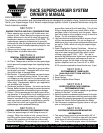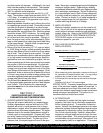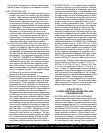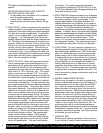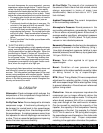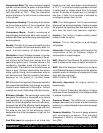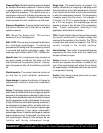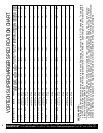
3
more overall horsepower and slower supercharger
speeds to attain a significant horsepower increase.
5. BELTS AND PULLEYS
a. Serpentine Drive Belts-The faster you spin a super-
charger, the greater the tendency for belt slippage
to occur. Most vehicles respond differently as to
when the slippage will occur. 6 rib systems are
more prone to slipping because they have less
surface area for the belt to grip. An inherent design
characteristic of serpentine belts is a certain amount
of belt slippage. This mainly occurs on deceleration,
but may also occur on acceleration if the belt is
too loose or if the belt being utilized is not of
sufficient width to transmit the horsepower being
generated. Excessive belt tension can lead to
supercharger or crankshaft bearing failure. For
high boost/impeller speed levels, use the widest
serpentine belt/pulley combination available.
b. Cog Pulley Drive Belts-The only Vortech super
charger designations that may be driven with a
cogged (non-slipping) type drive belt have special
internal modifications. There still exists the very
real possibility of supercharger damage when using
this type of drive, but this special configuration is
more tolerant. The configured units show a "RACE
H", "RACE M", "MARINE H" or "MARINE M" desig-
nation below the EO# box on the supercharger
identification name plate. Non-slipping cog-type
belts require less tension than serpentine belts
due to their design. Excessive belt tension can
lead to supercharger or crankshaft bearing failure.
Do not overtighten the belt. If in question, please
call Vortech to confirm your supercharger
specifications for drive purposes.
c. Miscellaneous Pulley Guidelines-The propensity
for grooved belts to move over one or more grooves,
or come off completely, is always due to an align-
ment problem. Either statically (the pulleys are
misaligned due to an installation or tolerance pro-
blem) or dynamically (the loading or unloading of
the system caused mainly by flex or movement of
the mounting plate) may cause misalignment.
Misalignment can also be caused by overtightening
(and failing) of the belt, which can negatively affect
the supercharger and crankshaft bearings. Some
non-Vortech pulleys do not provide the precision
fit and balance which are essential for performance
and durability and are therefore not recommended.
Never force or hammer on the pulley or superchar-
ger input shaft. The pulley should barely slip over
the shaft when it is 75-80°F. Always use a small
amount of oil or grease on the shaft. The key to
keyway fit is also critical, as is balance. The key
provided by Vortech is the proper length and weight
for a Vortech aluminum pulley. The use of steel
pulleys is not recommended due to their extra
weight and possible associated corrosion problems.
6. BYPASS VALVES - If the supercharger installation
is used for racing or if the pulley has been changed,
there exists the possibility of compressor surge (and
its associated heat buildup) or overspeeding of the
unit, either of which can lead to failure. Overspeeding
the supercharger can lead to bearing failure or impel-
ler rubbing. If no compressor bypass valve is used
in conjunction with increased impeller speeds, com-
pressor surge can exist, particularly during decel-
eration or during transmission shifts. This can lead
to heating and subsequent expansion of the impeller,
which can cause the impeller to rub the housing.
Needless zinging (free revving) of the engine can
destroy the supercharger if the pulley ratios are high,
especially if no bypass valve is installed. Any Vortech
supercharger that is producing more than 6 psi needs
a compressor bypass valve to prevent compressor
surge and possible failure of the supercharger. The
standard bypass valve (P/N 8D001-001), that Vortech
provides in most of its V-1 S-Trim, SC-Trim, T-Trim
and V-9 G-Trim street supercharger systems will be
sufficient to impeller speeds not exceeding 41,000
rpm and boost levels not to exceed 10 psi. If either
of these operating parameters is exceeded, then a
Vortech Maxflow Mondo Bypass Valve (part number
8D103-001) or Maxflow Race Bypass Valve (part
number 8D204-001) must be used to prevent com-
pressor surge. The above listed operating parameters
should also be used when running a V-1 A, B, S,
SC-Trim, V-5 D-Trim, G-Trim, F-Trim or V-9 G-Trim,
F-Trim on your application. Most V-1 R-Trim, V-1 T-
Trim, V-3 and V-7 superchargers require the above
mentioned racing or Mondo bypass valve when used
with high boost or racing applications. All V-4 super-
chargers require the use of two Mondo bypass valves
mounted in parallel. When using an adjustable
bypass valve, it is very important that it opens and
closes at the proper times. The valve should begin
opening between 3-4 inches of vacuum and be com-
pletely open between 6-8 inches of vacuum.
SECTION 8
SYSTEM OPERATING PARAMETERS AND
CONSIDERATIONS
1. SUPERCHARGER MOUNTING HARDWARE
Supercharger mounting brackets must be rigid to mini-
mize flex or vibration under racing conditions. Vortech
addressed this subject in the development of its race
bracket packages like the V-3/V-4 race bracket/pulley
package (P/N 4FP218-010) and the crank/strut sup-
port module (P/N 4FP110-010). Other manufacturer's
products may flex and cause severe vibrations under
certain extreme conditions. Vortech does not rec-
ommend mounting a strut rod from the supercharger
to any part of the body or shock tower due to exces-
sive vehicle body flexing (including solid motor mounts
or motor plates) evident during racing conditions.
© 2000 Vortech Engineering, Inc. All Rights Reserved. International Copyrights Secured. 25FEB00 V 2.0 DRAFT P/N: 008515
Questions?
Please contact: Vortech Engineering, Inc. • 1650 Pacific Ave., Channel Islands, CA 93033-9901
Phone: (805) 247-0226 • Fax: (805) 247-0669 • Website: vortechsuperchargers.com • Hours: M-F 8AM - 4:30PM (PST)



